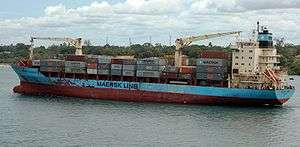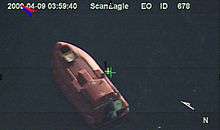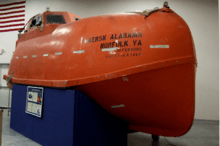MV Maersk Tygra
 | |
| History | |
|---|---|
| Name: |
|
| Owner: | A. P. Moller-Maersk Group |
| Operator: | Maersk Line, Limited |
| Port of registry: | |
| Builder: | China Shipbuilding Corporation[3] Keelung, Taiwan[1] |
| Yard number: | 676[3] |
| Launched: | 1998 |
| Completed: | 1998[3] |
| Maiden voyage: | 1998 |
| In service: | 1998 |
| Homeport: | Norfolk, Virginia, U.S. |
| Identification: | IMO number: 9164263[3] |
| Status: | In active service |
| General characteristics | |
| Type: | Container ship |
| Tonnage: | |
| Length: | |
| Beam: | 25.30 m (83 ft 0 in)[1] |
| Propulsion: | 1 Hitachi-Man 7S50 MC-C[4] |
| Speed: | In excess of 18 knots (33 km/h)[1][2] |
| Capacity: | 1,092 TEU[3] |
| Crew: | 21[5] |
MV Maersk Tygra (formerly Maersk Alabama) is a container ship owned by Maersk Line Limited and operated by Waterman Steamship Corporation.[6]
She has a light-blue hull and a beige superstructure like all Maersk vessels, regardless of their flag of registry.[7] She was hijacked by pirates near Somalia in 2009 and her crew held hostage. Four additional unsuccessful hijacking attempts were made later that year, 2010, and 2011.[8]
History
Alva Maersk was built by China Shipbuilding Corporation, Keelung, Taiwan at yard number 676 and launched in 1998.[9] As Alva Maersk, she was flagged to Denmark. In 2004, Alva Maersk was renamed Maersk Alabama[1] and reflagged to the United States, with its operator, Maersk Line, Limited, based in Norfolk, Virginia.[2] She has been involved in seven incidents, and remains in active service on Maersk Line's East Africa 4 service. Her regular route is from Mombasa, Kenya to Salalah, Oman, to Djibouti, and then returning to Mombasa.[2]
2004 detention
In 2004, the ship was detained in Kuwait after becoming the victim of an apparent fraud scheme. According to papers filed by the A. P. Moller-Maersk Group with the United States District Court for the Southern District of New York in 2005, Kuwait-based expatriates scammed the Group out of millions of dollars. Low-value goods were allegedly shipped under the guise of fraudulent, high-value bills of lading. Maersk was subsequently sued for losing goods that had never existed. Those allegedly behind the scheme were able to detain Alva Maersk in Kuwait as collateral. The ship was released in April 2004 after the A. P. Moller-Maersk Group was forced to put up $1.86 million as collateral.[10]
April 2009 attempted pirate seizure
On April 7, 2009, the U.S. Maritime Administration, following NATO advisories, released a Somalia Gulf of Aden advisory to mariners recommending ships to stay at least 600 nautical miles (1,100 km; 690 mi) off the coast of Somalia. On April 8, 2009, four Somali pirates boarded the Maersk Alabama when it was located 240 nmi (440 km; 280 mi) southeast of the Somalia port city of Eyl.[11] With a crew of 20, the ship was en route to Mombasa, Kenya. The ship was carrying 17,000 metric tons of cargo, of which 5,000 metric tons were relief supplies bound for Somalia, Uganda, and Kenya.[5][12]


According to Chief Engineer Mike Perry, the engineers sank the pirate speedboat shortly after the boarding by continuously swinging the rudder of the Maersk Alabama thus scuttling the smaller boat.[13] As the pirates were boarding the ship, the crew members locked themselves in the engine room[14] while the captain and two other crew members remained on the bridge. The engineers then took control of the ship from down below, rendering the bridge controls useless. The pirates were thus unable to control the ship. The crew later used "brute force" to overpower one of the pirates,[14] Abduwali Muse, and free one of the hostages, Abu Thair Mohd Zahid Reza. Frustrated, the pirates decided to leave the ship, and took Phillips with them to a lifeboat as their bargaining chip. The crew attempted to exchange this captured pirate, whom they had kept tied up for twelve hours,[15] for Captain Phillips. The captured pirate was released but the pirates refused to release Phillips in exchange. Since the battery had died on the open-air boat, they left in the ship's covered lifeboat, taking Phillips with them.[16] The lifeboat carried ten days of food rations, water and basic survival supplies.[17] On April 8, the destroyer USS Bainbridge and the frigate USS Halyburton were dispatched to the Gulf of Aden in response to a hostage situation, and reached Maersk Alabama early on April 9.[18] Maersk Alabama then departed from the area with an armed escort, towards its original destination in Mombasa, Kenya, with the vessel's Chief Mate Shane Murphy in charge.[14] On Saturday, April 11, Maersk Alabama arrived in the port of Mombasa, Kenya, still under U.S. military escort, where C/M Murphy was relieved by Captain Larry Aasheim, who had previously been captain of the Maersk Alabama until Richard Phillips relieved him eight days prior to the pirate attack. An 18-man marine security team was on board.[18] The FBI secured the ship as a crime scene.[19]
On April 9, a standoff began between the Bainbridge and the pirates in the Maersk Alabama's lifeboat, where they continued to hold Captain Phillips hostage.[20][21] Three days later, on Sunday, April 12, Navy marksmen opened fire and killed the three pirates on the lifeboat, and Phillips was rescued in good condition.[22][23] The Bainbridge captain Commander Frank Castellano, with prior authorization from U.S. President Barack Obama, ordered the action after determining that Phillips' life was in immediate danger, based on reports that a pirate was pointing an AK-47 assault rifle at his back.[24][25][26] U.S. Navy SEAL snipers on Bainbridge's fantail opened fire, killing the three pirates with bullets to the head,[27] one of whom was named Ali Aden Elmi, another whose last name was Hamac, and the third unidentified.[28] A fourth pirate, Abduwali Muse, aboard the Bainbridge and negotiating for Phillips' release while being treated for an injury sustained in the takeover of Maersk Alabama, surrendered and was taken into custody.[22][23] Muse's parents asked that he be pardoned because he was either 15 or 16 years old at the time of the incident, but in court it was ruled that he was not a juvenile and would be tried as an adult.[28] He later pleaded guilty to piracy charges and was sentenced to more than 33 years in prison.[28][29]
The actual lifeboat in which Captain Phillips was held hostage is now on display at the National Navy SEAL Museum in Ft. Pierce, FL.[30] An example of the Scan Eagle UAV used to monitor the crisis is also on display.[31]
November 2009 pirate attack
At 6:30 am on November 18, 2009, the Maersk Alabama was reportedly sailing some 350 nautical miles (650 km) east of Somalia when she was fired upon by four pirates wielding automatic weapons and traveling in a skiff.[8][32][33] The assault failed after guards on the ship responded with small arms fire and acoustical weapons.[34] Afterward, a Djibouti-based patrol plane flew to the scene and an EU ship searched the area.[35]
September 2010 suspicious approach of pirate skiff
29 September 2010, the vessel was targeted by Somali pirates wielding AK-47s. The security force on board the Maersk Alabama repelled a skiff with 5 pirates approximately 1,530 kilometres (950 mi) east of Somalia. The incident went unreported by the media until November 2010.[36]
March 2011 attempted hijacking
8 March 2011, the vessel was again targeted by Somali pirates.[37] A security force on board the Maersk Alabama fired warning shots and turned the suspects away.[38]
May 2011 attempted hijacking
Midnight, 14 May 2011, while transiting westbound in the international recognized corridor, Maersk Alabama was approached by a skiff of five pirates on the starboard stern. After turning to follow the ship's wake, the skiff quickly closed in to 30 metres (98 ft), preparing to board via a hook ladder, whereupon the embarked security team fired two shots into the skiff. The skiff quickly broke off and radar contact was lost after 10 minutes.[39]
February 2014 deaths of two security contractors
On 19 February 2014, it was reported that two former Navy SEALs working as security contractors aboard the Maersk Alabama for the private security firm Trident Group were found dead aboard the container ship, a day after it docked at Port Victoria, Seychelles.[40] Seychelles police officials reported that the autopsy found the cause of death to be "respiratory failure, with suspicion of myocardial infarction (heart attack)." The presence of a syringe and traces of heroin in the cabin led to a suspicion of drug use.[41] In April, following receipt of a toxicology report which found alcohol in the men's blood, police confirmed that death had been caused by consumption of alcohol and heroin.[42][43] Criminal investigations are continuing in Seychelles.[42] Seychelles law enforcement released the vessel on February 24.[44]
On February 26, 2014, the New York Times published a long profile of the two men, entitled "Hired to Fight Pirates, but Doomed by Boredom".[45] A team of eight journalists, reporting from around the world, reported that the suggestions of hard partying and drug use were completely out of character. Friends described both men as clean-living, heavily muscled, fitness enthusiasts. Reynolds did not drink alcohol. A work-out buddy of Kennedy said he was "so clean cut and chiseled that he was nicknamed Captain America."
Both Maersk and Trident prohibit drug use on board ship.[45]
See also
- Combined Task Force 150 and Combined Task Force 151, coalition counter-piracy operations in the region.
- Dai Hong Dan, a similar incident involving the hijacking of a North Korean ship.
- Joint Special Operations Command.
- MV Samho Jewelry, another hijacking involved in a similar rescue operation by South Korean forces.
- Operation Atalanta, a campaign of the European Union to stop the piracy off the Somali coast.
- Captain Phillips, a 2013 film starring Tom Hanks about the Maersk Alabama hijacking
- Piracy in Somalia.
Notes
{{cite news | url =http://www.foxnews.com/us/2014/02/19/2-american-contractors-found-dead-aboard-ship-featured-in-movie-captain-philips/| title =2 former Navy SEALs found dead aboard ship at center of ‘Captain Phillips’ saga | publisher =Fox News | date =2014-02-19 | archiveurl =https://web.archive.org/web/20140625195253/http://www.foxnews.com/us/2014/02/19/2-american-contractors-found-dead-aboard-ship-featured-in-movie-captain-philips/ | archivedate =2014-06-25 | accessdate =2014-10-23 | deadurl =No | quote =Details of the contractors' deaths remain unclear, but they were not on watch and did not die while performing a security operation, Tom Rothrauff, the president of the Trident Group, said. He said an initial assessment of the scene did not suggest any foul play. }} </ref> [41] [42] [43] [44] [45]; -webkit-column-width: 30em refs= [40] [41] [42] [43] [44] [45]; column-width: 30em refs= [40] [41] [42] [43] [44] [45]; list-style-type: decimal;">
- 1 2 3 4 5 6 7 8 "9164263". Miramar Ship Index. Retrieved April 8, 2009. (subscription required (help)).
- 1 2 3 4 "Maersk Alabama fact sheet". Maersk Press Release. Retrieved April 10, 2009.
- 1 2 3 4 5 "Maersk Alabama". Container-Info. Archived from the original on January 1, 2009. Retrieved April 8, 2009.
- ↑ http://www.intship.com/wp-content/uploads/2009/09/Specs_MaerskAlabama.pdf
- 1 2 "Somali pirates hijack Danish ship". BBC news. 2009-04-08. Retrieved 2009-04-08.
- ↑ "High Drama, High Stakes, High Seas – The Maersk Alabama Pirate Attack". SeaFever. April 8, 2009.
- ↑ "Shipping Companies (Denmark)". CRW Flags' Online Catalog. Retrieved 2009-04-09.
- 1 2 Cowell, Alan (November 18, 2009). "Pirates Attack Maersk Alabama Again". The New York Times. Retrieved November 18, 2009.
- ↑ "Lawfare – Maersk Alabama a crime scene". EagleSpeak. April 11, 2009.
- ↑ "Maersk A-Class". GlobalSecurity.org. Retrieved 2009-04-09.
- ↑ Sanders, Edmund; Barnes, Julian E. (April 9, 2009). "Somalia pirates hold U.S. captain". Los Angeles Times. Retrieved April 12, 2009.
- ↑ "Ship carrying 20 Americans believed hijacked off Somalia". CNN. 2009-04-09. Retrieved 2009-04-09.
- ↑ "Crewman's e-mail gives harrowing details of hijacking". CNN. April 20, 2009. Retrieved 6 July 2010.
- 1 2 3 "American Captain 'Unharmed' in Lifeboat – ABC News". Abcnews.go.com. 2009-04-09. Retrieved 2012-06-19.
- ↑ "Africa | FBI in hostage talks with Somalis". BBC News. 2009-04-09. Retrieved 2009-04-09.
According to second mate Ken Quinn, the crew managed to capture one of the pirates and keep him tied up for 12 hours
- ↑ The True Tale of Captain Phillips Time, 12 October 2013. Retrieved 12 November 2014.
- ↑ "Cargo ship heads for Kenya". CNN. 2009-04-08. Retrieved 2009-04-09.
- 1 2 "U.S. Warship Shadows Somali Pirates With Hostage". Associated Press. April 9, 2009. Archived from the original on April 11, 2009. Retrieved April 12, 2009.
- ↑ "WRAPUP 10-U.S. Navy rescues captain, kills Somali pirates". Reuters. April 12, 2009.
- ↑ Houreld, Katharine; Muhumed, Malkhadir M. (April 10, 2009). "Pirates recapture US hostage after escape attempt". Associated Press. Retrieved April 12, 2009.
- ↑ "Pirates Hold American Captain Hostage; Negotiations Continue for Release". The NewsHour with Jim Lehrer. April 9, 2009. Retrieved April 12, 2009.
- 1 2 Verjee, Zain; Starr, Barbara (April 12, 2009). "Captain jumps overboard, SEALs shoot pirates, official says". CNN. Retrieved April 12, 2009.
- 1 2 "US captain held by pirates freed". BBC News. April 12, 2009. Retrieved April 14, 2009.
- ↑ "Official: US sea captain faced imminent danger". Associated Press. April 12, 2009. Retrieved 31 March 2014.
- ↑ Mikkelsen, Randall (April 12, 2009). "US acted after pirates aimed at ship captain". Reuters. Archived from the original on April 14, 2009. Retrieved April 12, 2009.
- ↑ "US captain rescued from pirates". BBC News. April 13, 2009. Retrieved April 13, 2009.
- ↑ Hostage captain rescued; Navy snipers kill 3 pirates CNN, April 12, 2009
- 1 2 3 Hassan, Abdiqani (2009-04-22). "Somali Pirate Families Ask for U.S. Pardon". Reuters. Retrieved 22 April 2009.
- ↑ "Somali pirate sentenced to 33 years in US prison". BBC News. 16 February 2011. Retrieved 16 February 2011.
- ↑ The actual lifeboat from Maersk Alabama is now at the SEAL Museum: https://navysealmuseum.com/home-to-artifacts-from-the-secret-world-of-naval-special-warfare/maersk-alabama-lifeboat-and-mk-25-sniper-rifle-from-easter-seal-rescue/
- ↑ https://navysealmuseum.com/home-to-artifacts-from-the-secret-world-of-naval-special-warfare/unmanned-aerial-vehicle-uav-scan-eagle/
- ↑ "Maersk Alabama thwarts Somali pirate attack". USA Today. 2009-11-18. Retrieved 2010-04-07.
- ↑ Childress, Sarah (November 18, 2009). "Maersk Alabama Evades Second Pirate Attack". The Wall Street Journal. Retrieved November 18, 2009.
- ↑ "U.S. ship thwarts second pirate attack". CNN. November 18, 2009. Retrieved November 18, 2009.
- ↑ "Pirates strike same US ship again". BBC News. November 18, 2009. Retrieved November 18, 2009.
- ↑ Fitzpatrick, David (22 November 2010). "Pirates set sights on Maersk Alabama again, maritime group says". CNN. Retrieved 15 May 2011.
- ↑ "Maersk Alabama targeted again by Somali pirates, CNN reports". 9 March 2011. Retrieved 9 March 2011.
- ↑ "Pirates target the Maersk Alabama again". CNN. 9 March 2011. Retrieved 9 March 2011.
- ↑ "SECURITY TEAM ABOARD MAERSK ALABAMA REPELS PIRATE ATTACK". Bridgdeck. Retrieved 17 May 2011.
- 1 2 3 "2 former Navy SEALs found dead aboard ship at center of 'Captain Phillips' saga". Fox News. 2014-02-19. Archived from the original on 2014-06-25. Retrieved 2014-10-23.
Details of the contractors' deaths remain unclear, but they were not on watch and did not die while performing a security operation, Tom Rothrauff, the president of the Trident Group, said. He said an initial assessment of the scene did not suggest any foul play.
- 1 2 3 4 Elizabeth Landau (2014-02-26). "Mystery shrouds 'Captain Phillips' ship deaths". CNN. Archived from the original on 2014-10-08. Retrieved 2014-10-23.
Seychelles police say the autopsy found the cause of death to be "respiratory failure, with suspicion of myocardial infarction (heart attack)." The presence of a syringe and traces of heroin in the cabin have led to a suspicion of drug use, police said.
- 1 2 3 4 5 Brumfield, Ben (29 April 2014). "Police: Heroin, alcohol at fault in death of security officers on 'Captain Philips' ship". CNN. Archived from the original on 2014-05-02. Retrieved 1 May 2014.
Police said toxicologists in Mauritius found alcohol in the blood of Jeffrey Reynolds, 44, and Mark Kennedy, 43, who both suffered respiratory failure and heart attacks. Foul play was ruled out.
- 1 2 3 4 "Drugs Responsible for Maersk Alabama Deaths". Maritime Executive. 30 April 2014. Retrieved 1 May 2014.
- 1 2 3 4 "Heart attack and respiratory failure in Maersk deaths". BBC News. 2014-02-24. Archived from the original on 2014-10-23.
Mark Daniel Kennedy, 43, and Jeffrey Keith Reynolds, 44, were found dead on 18 February as the ship was berthed in Port Victoria, the capital of the Indian Ocean island nation of Seychelles.
- 1 2 3 4 5 Nicholas Kulish, Ian Urbina, Mark Mazzetti, Jeremy Alford, Christopher Drew, Kristina Rebelo, Susan Beachy, Kitty Bennett (2014-02-26). "Hired to Fight Pirates, but Doomed by Boredom". Victoria, Seychelles: New York Times. p. A1. Archived from the original on 2014-07-10. Retrieved 2014-10-23.
While veterans, especially those returning from war zones, have shown a high prevalence of substance abuse and other risky behaviors, friends, family and acquaintances of the two men said they seemed to have adjusted well to civilian life after years in the military. They were known as much for their zest for life as their hulking physiques.
External links
| Wikinews has related news: US crew retakes ship hijacked by pirates; captain held hostage |
| Wikinews has related news: Somali pirates attack US-flagged ship, vessel evades capture |
- Hijackers on Cargo Ship: 'They Ran' – Associated Press on YouTube
- U.S. Crew Re-Captures Ship From Pirates at ABC News